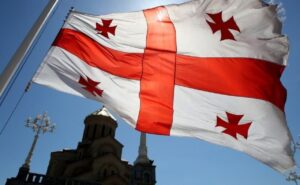
Most Ukrainians have a positive opinion of Georgia, according to the results of a survey conducted by Active Group in collaboration with the analytical center Experts Club.
According to the study, 56.3% of Ukrainians expressed a positive attitude towards Georgia: among them, 14.3% are completely positive, and 42.0% are mostly positive.
At the same time, 10.7% of respondents have a negative attitude (1.7% completely negative and 9.0% mostly negative). A third of respondents (32.3%) remain neutral, while another 0.7% admitted that they are not sufficiently knowledgeable about the country.
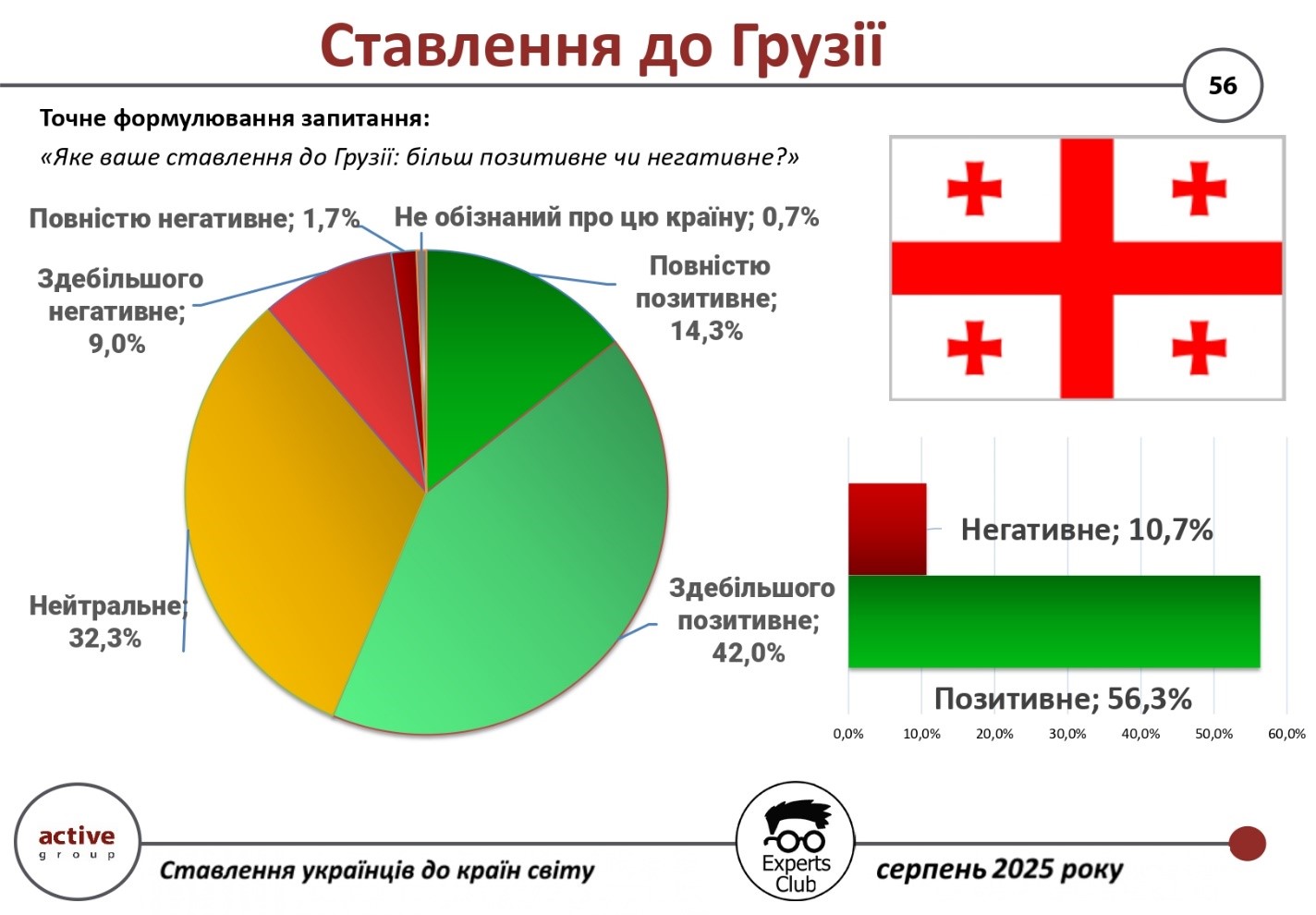
At the end of 2024, Ukraine’s trade turnover with Georgia amounted to $1,828.2 million. Exports of Ukrainian goods to Georgia reached $1,360.8 million, while imports amounted to $467.4 million. Thus, Ukraine had a positive bilateral trade balance of $893.4 million.
According to economist and founder of Experts Club Maksim Urakin, the positive balance with Georgia reflects a sustained interest in mutual cooperation:
“Georgia traditionally remains an important trading partner for Ukraine in the Caucasus. The high level of positive attitudes among Ukrainians toward this country is a favorable foundation for the further development of economic and cultural relations,” the expert emphasized.
Thus, Georgia is among the group of countries that Ukrainians view mostly positively, and strong economic ties and shared historical proximity create the basis for further deepening the partnership.
The full video can be viewed at: https://www.youtube.com/watch?v=YgC9TPnMoMI&t
You can subscribe to the Experts Club YouTube channel here: https://www.youtube.com/@ExpertsClub
ACTIVE GROUP, EXPERTS CLUB, GEORGIA, Pozniy, SOCIOLOGY, TRADE, UKRAINE, URAKIN

A survey conducted by Active Group in collaboration with Experts Club showed that most Ukrainians refrain from giving clear assessments of Malaysia: 68.3% of respondents said they had a neutral attitude toward this country.
At the same time, 18.7% of Ukrainians expressed a positive attitude (in particular, 2.3% said they were “completely positive” and 16.3% said they were “mostly positive”), while 4.7% expressed a negative attitude. Another 8.3% of respondents admitted that they did not have enough information about Malaysia to form an opinion.
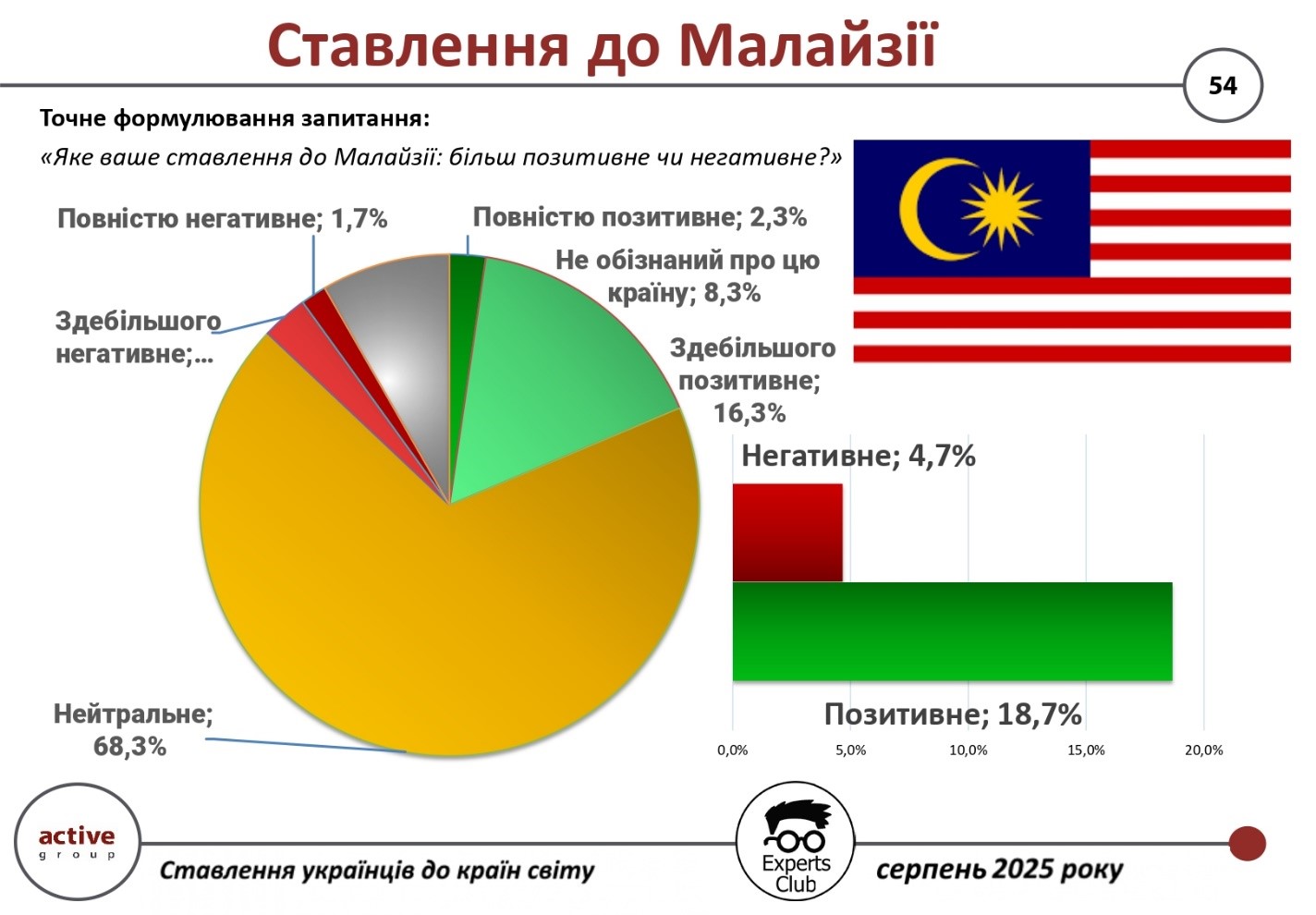
According to the results of Ukraine’s foreign trade with Malaysia in the first half of 2025, the trade turnover amounted to $193.8 million. At the same time, Ukrainian exports amounted to only $41.2 million, while imports from Malaysia reached $152.6 million.
Thus, the negative balance for Ukraine amounted to $111.4 million, which indicates a significant dependence on Malaysian imports.
The founder of Experts Club, economist Maksim Urakin, emphasized that in relations with Malaysia, it is worth focusing on expanding Ukraine’s export opportunities.
“Today, we see a significant imbalance in trade with Malaysia, which reduces the economic effect of cooperation for Ukraine. A promising direction could be agro-industrial exports, in particular products from the food and processing industries. At the same time, the neutral attitude of most Ukrainians opens up space for the development of cultural and information diplomacy,” the expert stressed.
The full video can be viewed at: https://www.youtube.com/watch?v=YgC9TPnMoMI&t
You can subscribe to the Experts Club YouTube channel here: https://www.youtube.com/@ExpertsClub
ACTIVE GROUP, EXPERTS CLUB, MALAYSIA, Pozniy, SOCIOLOGY, TRADE, UKRAINE, URAKIN
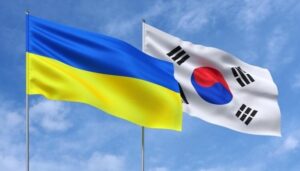
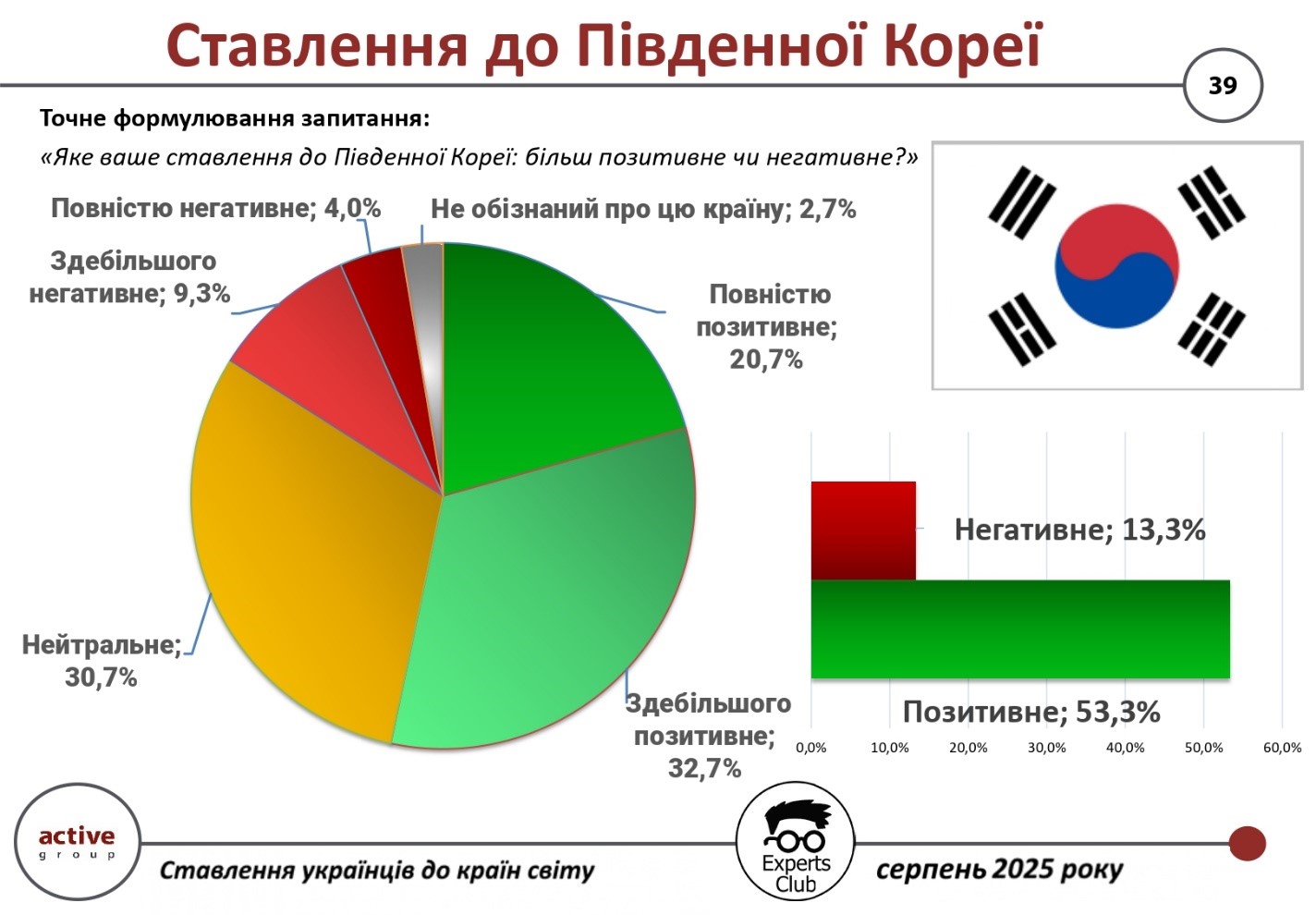
According to a survey conducted by Active Group in cooperation with Experts Club in August 2025, more than half of Ukrainians have a positive opinion of South Korea.
In total , 53.3% of respondents expressed favorable attitudes toward this country (32.7% – mostly positive, 20.7% – completely positive). A neutral attitude was recorded in 30.7% of respondents, and negative assessments amounted to 13.3%. Another 2.7% said they did not know enough about the country.
“South Korea is perceived by Ukrainians as a modern high-tech country that is developing dynamically and at the same time preserving its cultural identity. Ukrainians see it as a potential partner, especially in the field of technology, education, and innovation,” said Oleksandr Poznyi, CEO of Active Group.
At the same time, Maksym Urakin, co-founder of Experts Club, emphasized the economic dimension of bilateral relations:
“In the first half of 2025, the total trade turnover between Ukraine and the Republic of Korea amounted to more than $518 million. Exports of Ukrainian goods amounted to only $96.9 million, while imports amounted to more than $421 million. This resulted in a negative trade balance of $324 million. The situation demonstrates the need for more active promotion of Ukrainian goods to the Korean market, particularly in the agricultural and food sectors,” he emphasized.
The research is part of the systematic monitoring of Ukraine’s international relations and public opinion about its partners in the world.
The full video can be viewed here:
https://www.youtube.com/watch?v=YgC9TPnMoMI&t
You can subscribe to the Experts Club YouTube channel here:
https://www.youtube.com/@ExpertsClub
ACTIVE GROUP, EXPERTS CLUB, Poznyi, SOCIOLOGY, SOUTH KOREA, TRADE, UKRAINE, URAKIN

Ukrainians are mostly neutral about the United Arab Emirates (UAE), but among those who have a definite opinion, positive assessments significantly outweigh negative ones. This is evidenced by the results of a sociological study conducted by Active Group in collaboration with the analytical center Experts Club.
According to the survey, 53.7% of respondents took a neutral position on the UAE. At the same time, 38.3% of Ukrainians expressed a positive attitude (7.3% — completely positive, 31.0% — mostly positive). Only 6.3% of respondents had a negative opinion of the country (1.7% — completely negative, 4.7% — mostly negative). Another 1.7% responded that they were not familiar with this country.
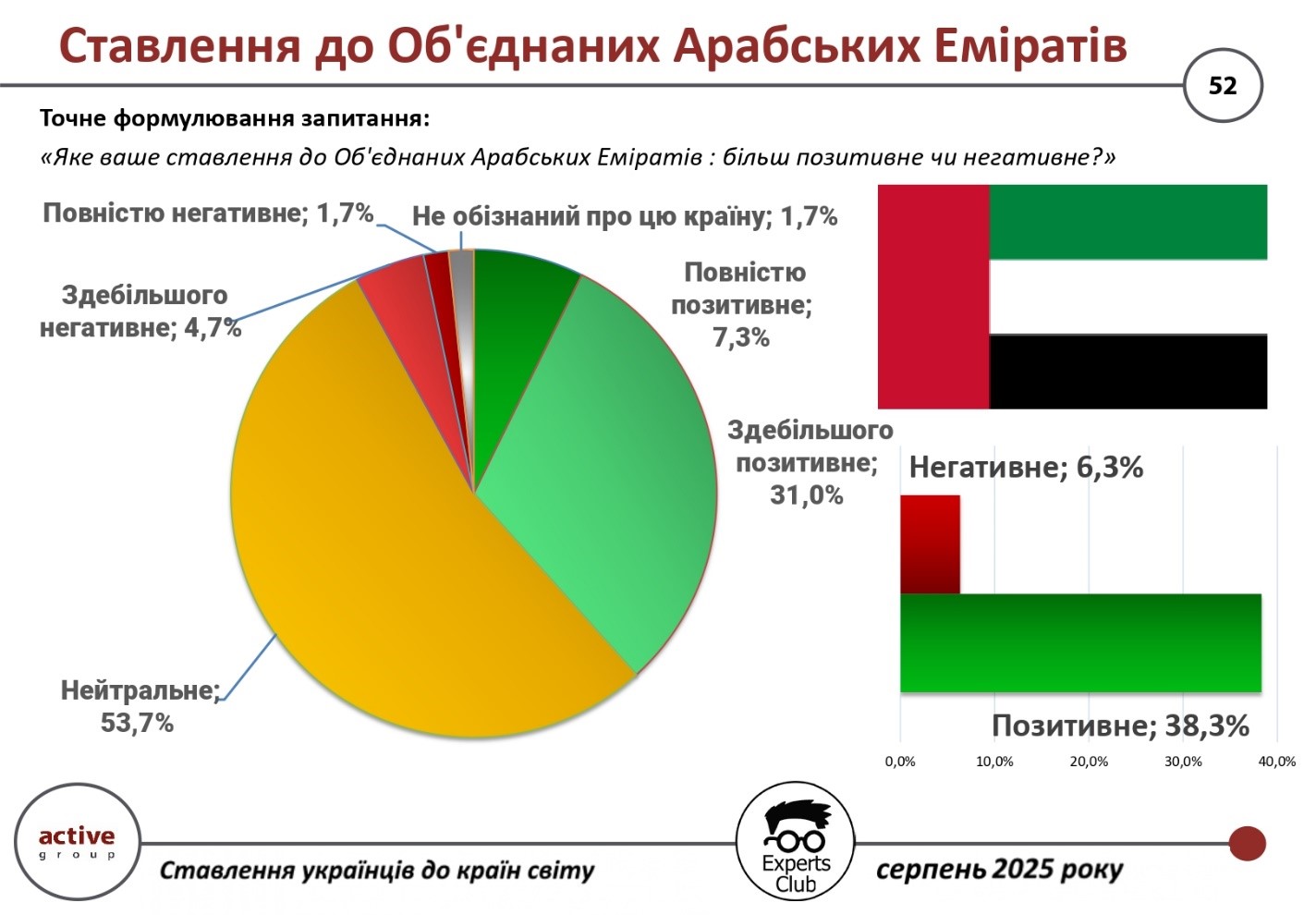
“Ukrainians perceive the UAE as a modern country with a developed economy that attracts tourists and business. Despite the remoteness of the region, the country’s image remains consistently positive,” said Alexander Pozniy, head of Active Group.
In turn, Maksim Urakin, co-founder of Experts Club, emphasized the stability of trade and economic relations between Ukraine and the UAE:
“In January-August 2025, the total trade turnover between the countries amounted to $234.1 million. At the same time, exports from Ukraine to the UAE amounted to $173.2 million, while imports amounted to only $60.9 million. The positive balance for Ukraine reached $112.4 million, which makes cooperation with the Emirates beneficial for our economy.”
Thus, the United Arab Emirates remains a country with a moderately positive image among Ukrainians and demonstrates a stable surplus in trade relations with Ukraine.
The full video can be viewed at: https://www.youtube.com/watch?v=YgC9TPnMoMI&t
You can subscribe to the Experts Club YouTube channel here: https://www.youtube.com/@ExpertsClub
ACTIVE GROUP, EXPERTS CLUB, Pozniy, SOCIOLOGY, TRADE, UAE, UKRAINE, URAKIN

Ukraine’s real gross domestic product (GDP) grew by 0.8% in the second quarter of 2025 compared to the second quarter of 2024, while in the first quarter of this year the same indicator was 0.9%, according to the State Statistics Service.
According to its data, compared to the previous quarter, taking into account seasonal factors, real GDP increased by 0.2%.
As reported, in July, the NBU once again lowered its expectations for Ukraine’s economic growth this year to 2.1% from 3.1% in its April macroeconomic forecast, while the Ministry of Economy and the government maintain their forecast of 2.7%.
The National Bank of Ukraine estimated real GDP growth in the second quarter of 2025 at 1.1% compared to the same period last year, while previously forecasting it at 1.6%. According to its updated forecast, real GDP growth in the third quarter of this year has been revised down to 2.4% from 3.5%, and in the fourth quarter to 3.5% from 5.9%.
According to the State Statistics Service, Ukraine’s GDP growth slowed to 2.9% in 2024 from 5.5% in 2023, following a 28.8% decline in 2022, the first year of full-scale Russian aggression. In the fourth quarter of last year, GDP fell by 0.1% after growing by 2.2% in the third quarter, 4.0% in the second quarter, and 6.8% in the first quarter.
The NBU forecasts GDP growth of 2.3% for next year, while the government forecasts 2.4%.
Earlier, Experts Club analyzed the state of the economy in Ukraine and leading world countries. For more details, see the video at https://www.youtube.com/watch?v=kQsH3lUvMKo&t
You can subscribe to the Experts Club YouTube channel here: https://www.youtube.com/@ExpertsClub

The vast majority of Ukrainians do not have a clearly formed attitude towards Bangladesh. This is evidenced by the results of a sociological survey conducted by Active Group in cooperation with the Experts Club analytical center.
According to the data, 72.3% of respondents chose the “neutral attitude” option. 9.7% of respondents expressed a positive opinion (2.7% — completely positive, 7.0% — mostly positive). A negative attitude was declared by 7.7% of Ukrainians (1.0% — completely negative, 6.7% — mostly negative). At the same time, 10.3% responded that they did not have sufficient information about this country.
“For most Ukrainians, Bangladesh remains a relatively distant country about which there is a lack of information. This explains the high level of neutral responses,” said Alexander Pozniy, head of Active Group.
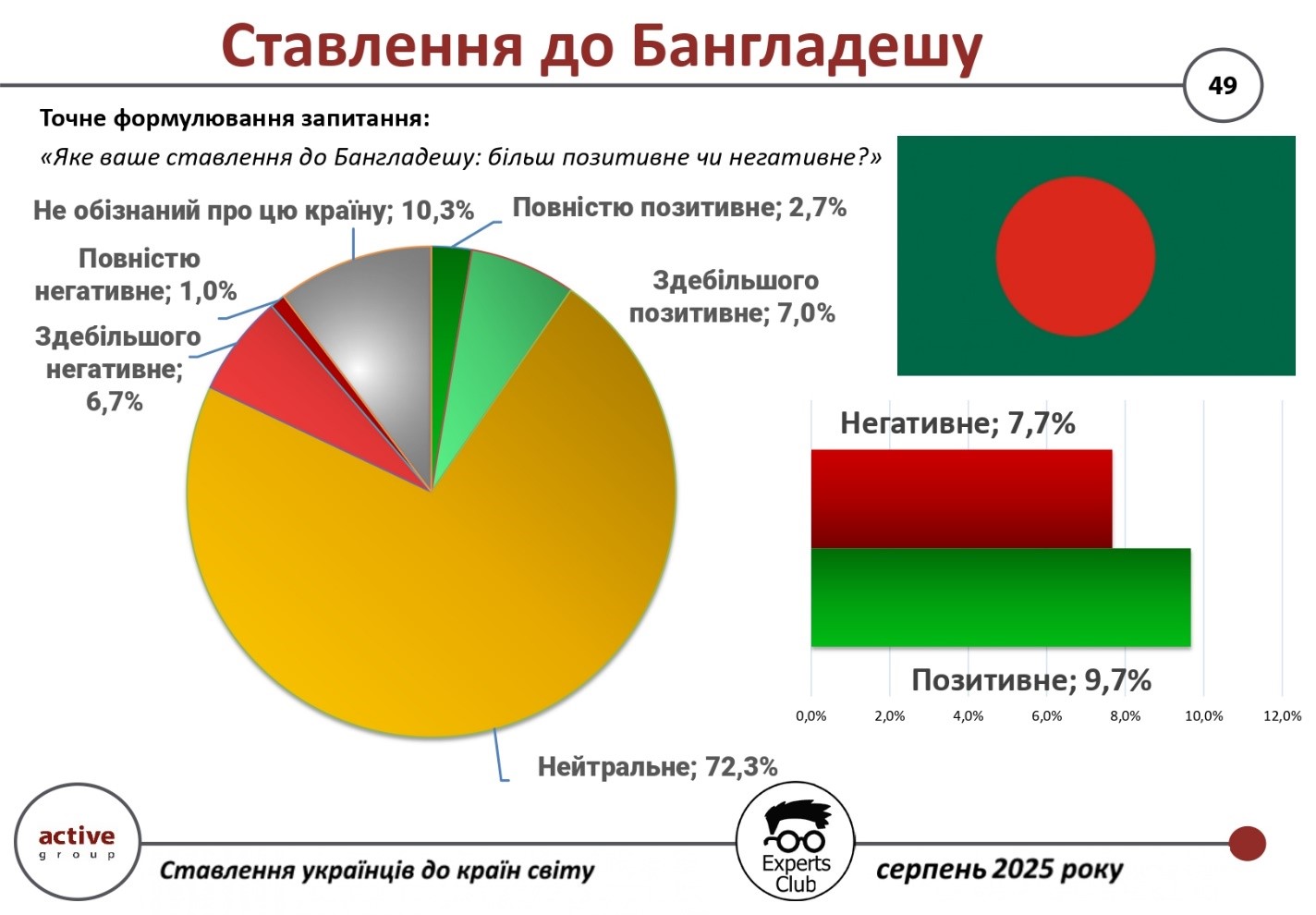
At the same time, Experts Club co-founder Maksim Urakin emphasized the importance of economic relations.
“According to the results of the first eight months of 2025, Ukraine’s trade turnover with Bangladesh amounted to $226.9 million. Exports from Ukraine reached $127.9 million, while imports amounted to $99.1 million. The positive balance of $28.8 million indicates balance and potential for expanding bilateral trade.”
Thus, despite Ukrainians’ lack of awareness about Bangladesh, economic cooperation is developing dynamically, creating the conditions for strengthening mutual interest.
The full video can be viewed at: https://www.youtube.com/watch?v=YgC9TPnMoMI&t
You can subscribe to the Experts Club YouTube channel here: https://www.youtube.com/@ExpertsClub
ACTIVE GROUP, BANGLADESH, EXPERTS CLUB, Pozniy, SOCIOLOGY, TRADE, UKRAINE, УРАКИН